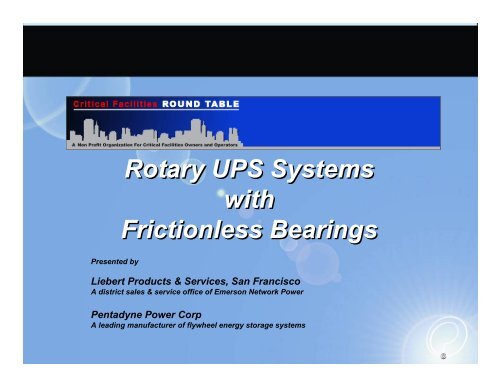Rotary UPS Systems with Frictionless Bearings - Critical Facilities ...
Rotary UPS Systems with Frictionless Bearings - Critical Facilities ...
Rotary UPS Systems with Frictionless Bearings - Critical Facilities ...
Create successful ePaper yourself
Turn your PDF publications into a flip-book with our unique Google optimized e-Paper software.
<strong>Rotary</strong> <strong>UPS</strong> <strong>Systems</strong><br />
<strong>with</strong><br />
<strong>Frictionless</strong> <strong>Bearings</strong><br />
Presented by<br />
Liebert Products & Services, San Francisco<br />
A district sales & service office of Emerson Network Power<br />
Pentadyne Power Corp<br />
A leading manufacturer of flywheel energy storage systems
Traditional Power Quality Configuration<br />
ATS<br />
<strong>UPS</strong><br />
Protected<br />
load<br />
Utility feed<br />
Back-up<br />
genset<br />
Batteries<br />
The Weakest Link
A better way<br />
Flywheel Batteries<br />
Lead-Acid Batteries<br />
Installation cost<br />
Low<br />
High<br />
Lifecycle Cost<br />
Footprint<br />
Maintenance<br />
Life expectancy<br />
Standby energy use<br />
Small<br />
infrequent<br />
>20 Years<br />
Very low to high<br />
Medium to large<br />
Frequent<br />
2 – 4 years<br />
Low<br />
Air conditioning cost<br />
None to low<br />
Medium<br />
Reliability<br />
Recharge<br />
Diagnostics and monitoring<br />
Known state of charge<br />
Dropped load MTBF<br />
Rapid<br />
Precise, real-time<br />
Yes<br />
>350,000 hours<br />
Very slow<br />
Speculative<br />
Unpredictable<br />
~30,000 hours<br />
Environment<br />
and Safety<br />
Operating temperature range<br />
Hazardous materials<br />
Explosive and toxic gas emissions<br />
Disposal requirements<br />
Very broad<br />
None to very few<br />
None<br />
None<br />
Very narrow<br />
Yes<br />
Yes<br />
Yes<br />
Ventilation requirements<br />
Minimal<br />
Yes
Flywheel/<strong>Rotary</strong> <strong>Systems</strong>
High-Reliability Configuration<br />
ATS<br />
<strong>UPS</strong><br />
Protected<br />
load<br />
Utility feed<br />
Back-up<br />
genset<br />
Flywheel<br />
Optional<br />
batteries
Battery “Whiplash” Prevented<br />
Float Voltage<br />
Grid Disturbance<br />
<strong>UPS</strong> DC Bus Voltage<br />
Coup de fouet = Whiplash<br />
99% of disturbances<br />
< 10 sec. --EPRI<br />
w/flywheel<br />
Gen<br />
0 10<br />
20<br />
Time (Seconds)<br />
• Programmable discharge is set above the battery discharge voltage<br />
• Flywheel isolates the batteries from ALL short-term cycling events<br />
• If event lasts longer that flywheel capacity, flywheel gently rolls down<br />
voltage into the battery set; eliminating battery coup de fouet
Storage: <strong>Critical</strong> to Every Event<br />
The 1st 10 seconds matter 100% of the time<br />
The next 10+ seconds matter less than 1%<br />
• EPRI confirms 99% of<br />
power disturbances<br />
are
Genset Start Reliability<br />
• IEEE Gold Book 493-2007 Annex L, Table XII:<br />
• Circa-1980 studies encompassing >26,000 genset starts<br />
• Starting reliability was proven to average 99.5%<br />
• These studies involved gensets made in the 1980s or earlier<br />
• Starting reliability of<br />
modern gensets, properly<br />
maintained and exercised,<br />
would arguably show<br />
higher first-attempt<br />
reliability
“15 Minutes” of Ridethrough<br />
• In reality: 60 seconds or less <strong>with</strong> 10-kW racks<br />
• If genset(s) aren’t up and driving cooling <strong>with</strong>in 60 seconds,<br />
servers will crash on thermal overload*<br />
• Higher rack power<br />
= even less time<br />
• Advantage of 15<br />
min. of batteries?<br />
• One data center<br />
operator said: “So I’ll<br />
have 15 minutes to<br />
update my resume.”<br />
* Source: Aperture Research Institute 2007
One Line<br />
Flywheel Module<br />
IGBT Power Converter<br />
Soft Start<br />
To <strong>UPS</strong><br />
Battery<br />
Input<br />
Speed<br />
Sensors<br />
Temperature<br />
Sensors<br />
Position<br />
Sensors<br />
DC Monitoring<br />
Motor Generator Controls<br />
Power Conversion Module Controller<br />
Magnetic Levitation<br />
Module<br />
COM<br />
AC Aux<br />
Backup<br />
Remote Monitoring<br />
& Controls<br />
(Optional)
Flywheel Technology Evolution<br />
Flywheel Technology<br />
Evolution<br />
KE = m(v²)<br />
• “Low-speed” 7,800 rpm<br />
• More mass means more energy<br />
• Double mass = energy doubled<br />
• Heavy (600 lbs)<br />
• Large puck<br />
• Mechanical bearings<br />
• Minor service every 12 months,<br />
major service every 30 months<br />
• High standby power<br />
consumption: 2,500W<br />
• “High-speed” 52,000 rpm<br />
• More speed means more energy<br />
• Double rpm = energy quadrupled<br />
• Light (52 lbs)<br />
• Compact cylinder<br />
• Full magnetic levitation<br />
• Minor service in first 6 months,<br />
then moderate service every 6 yrs<br />
• Very low standby power<br />
consumption: 250W
Full Magnetic Levitation<br />
Full MagLev = No Mechanical <strong>Bearings</strong><br />
• Magnetic levitation system fully<br />
floats the spinning mass<br />
• No bearings, no contact<br />
• No wear, no friction, no heat<br />
• No costly maintenance<br />
• Strong and robust
Aerodynamic Drag<br />
Maintaining Vacuum<br />
• Spinning mass is always<br />
throwing off gas molecules<br />
• Almost all flywheels have a<br />
constantly operating mechanical<br />
pump to maintain vacuum level<br />
• Unpredictable single point of failure<br />
• System will fault out <strong>with</strong>in 1 hr<br />
• One model uses a grooved sleeve and<br />
high velocity to evacuate stray molecules<br />
• Eliminates unpredictable failure<br />
• Cuts energy consumption and noise
Footprint Comparison<br />
• Floorspace needed by 5-minute VRLA cabinets for a 400-kVA <strong>UPS</strong> is nearly<br />
double that of a similar capacity pair of flywheels (green). Compared to a one<br />
megawatt set of wet cells, the flywheel footprint is nearly 80% less (orange).<br />
VRLA<br />
VRLA<br />
FW FW<br />
FW FW FW FW FW<br />
access<br />
access<br />
access<br />
access<br />
access<br />
wet cell array<br />
wet cell array<br />
access<br />
access
Floor-Loading<br />
• Lightest flywheel cabinet: 1,300 lbs<br />
• Comparable VRLA battery cabinet: ~5,000 lbs
Green Technology<br />
• Elimination of Hazardous Materials<br />
• No lead mining, smelting, transport, disposal etc.<br />
• No sulfuric acid disposal<br />
• No toxic, explosive or greenhouse gas emissions<br />
• No disposal/replacement after only a few years of service<br />
• Energy Use Reduction<br />
• Most efficient flywheel uses only 250 watts “float” charge<br />
• About ½ or less than that of batteries<br />
• About 1/10 th that of other flywheels<br />
• Annual savings per unit deployed<br />
• 20,000 kWh<br />
• 26,000 lbs of utility carbon emissions<br />
• Only 850 Btu/hr of heat vs. >8,500 Btu/hr of steel flywheel<br />
• No cooling requirements for Pentadyne flywheels<br />
• Ultra-efficient rapid recharge from full discharge in seconds<br />
• Batteries need weeks of energy use to do a full recharge
Sustainability Benefits<br />
During its 20-year life, each flywheel<br />
deployed mitigates the use of at least<br />
15,000 pounds of virgin lead and<br />
hundreds of gallons of sulfuric acid.<br />
“Lead is ranked 2 nd in<br />
US for all hazardous<br />
materials and<br />
requires proper<br />
disposal” - EPA<br />
Lead-acid batteries also emit ozonedepleting<br />
gases, contributing to global<br />
warming.<br />
The mining, smelting, refining,<br />
transporting and disposal of so much<br />
virgin lead requires an enormous use of<br />
low-efficiency energy and its resulting<br />
carbon footprint
The OTHER Green Advantage<br />
$300,000<br />
$2 50 ,0 00<br />
5-min VRLA Steel FW A Steel FW B Carbon FW<br />
$200,000<br />
$150 ,0 00<br />
$100,000<br />
$50 ,0 00<br />
$0
Relatively New, But Well Proven<br />
• >3,000 flywheel energy<br />
storage systems sold<br />
• >50M hours of total<br />
commercial fleet runtime<br />
• Compared to battery<br />
strings deployed over<br />
the same time periods,<br />
>1,000% greater proven reliability<br />
NASA Tech Scott Marabito checks runtime hours<br />
on their flywheel that’s been operating since 2004.
Example – Small Colocation<br />
NetAlliant: Tennessee<br />
150-kVA <strong>UPS</strong><br />
1 flywheel<br />
No batteries<br />
Protecting server loads<br />
Ride-through to gensets<br />
Drivers:<br />
Short battery life<br />
Batteries had dropped load<br />
Other bad experiences <strong>with</strong><br />
batteries<br />
Reliability
Example – Research Data Center<br />
Technology Center: Nebraska<br />
• Six 750-kVA <strong>UPS</strong>s<br />
• 24 flywheel systems (4.5 MW)<br />
• Protecting data center loads<br />
• No batteries<br />
• Drivers:<br />
• Increase total system reliability<br />
• Eliminate batteries & maintenance<br />
• Green, sustainable solution<br />
• Reduce O&O costs<br />
• Minimize footprint<br />
• Saved $180,000 in construction<br />
costs that would have been<br />
needed to for wet cells
Example – Utility<br />
Southern California Edison: California<br />
• 300-kVA <strong>UPS</strong><br />
• Two flywheels<br />
• Protecting data and other loads<br />
• Drivers:<br />
• Battery reliability issues<br />
• Battery maintenance issues<br />
• Wanted green, high-tech solution<br />
• Reduce O&O costs<br />
President Obama visited this SCE facility in ’09; the <strong>UPS</strong><br />
and part of one of the flywheels are visible behind him
Example - Transportation<br />
Mineta San José International Airport: California<br />
Now in “The OC” too!<br />
• 50kVA <strong>UPS</strong><br />
• 1 flywheel<br />
• Protecting radar and<br />
other critical loads<br />
• Battery parallel<br />
• Flywheel is first line<br />
of defense<br />
• Ride-through to genset<br />
• Drivers:<br />
• Reliability issues<br />
• Maintenance issues
Example – Military<br />
Missle Silos: Hundreds of Sites Nationwide<br />
• VFD energy recycling<br />
• ICBM modernization program<br />
• High inrush power needs<br />
• Poor utility conditions at remote sites<br />
• >500 flywheel systems are being<br />
deployed around the nation
Brian Handley: brian.handley@emerson.com - (925) 398-0018<br />
Keith Field: keith.field@pentadyne.com – (818) 836-1241














